Warm up this winter with Oma's newest cookbooks - available on Amazon >>
- Home
- German Food Guide
- The History of Marzipan
The History of Marzipan and Lübeck: The Marzipan Capital of The World
By: Lydia Fulson / Writer, Pyrography Artist, Thrill Seeker, and Traveler
The history of marzipan starts in a not-so-little town called Lübeck, the marzipan capital of the world! Let's find out how it all began and the best treats to try when visiting Lübeck.
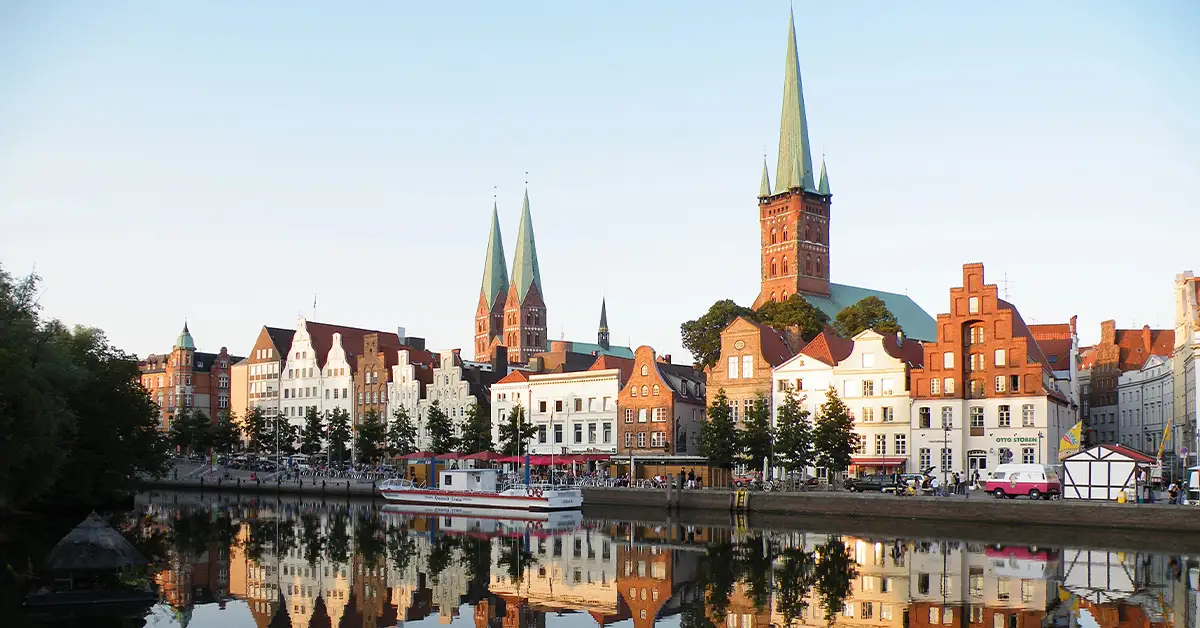
Lübeck is the second largest city on Germany's Baltic coast. It's big but not bustling with craziness like the main cities such as Berlin. Lübeck is a quiet, big city. My only complaint about it is that I didn't get more time here!
The various cafés, architectural sites, and exciting activities that Lübeck offers make it an appealing tourist stop. One thing put Lübeck on the map, and that is marzipan. When visiting Lübeck, one can't turn a few corners without bumping into marzipan.
FUn FACT
National Marzipan Day is on January 12th, every year. What a better time to visit Lübeck!
On this page:
What is Marzipan? How is it Made?
Marzipan is a delectable treat for my family, and is something that we always serve at Christmas time. Oma serves these amazing marzipan cookies covered in chocolate. These have been favorites of mine since I was little. For many who didn't grow up exposed to it like I did, it can be an acquired taste at first.
The tasty confection is made with ground almonds, typically mixed with sugar, egg whites, and a sweetener like corn syrup or honey. This creates a thick almond paste. In many recipes, bakers add a little almond extract or almond oil to amp up the almond flavor.
The paste created is easy to mold, making it a handy ingredient to add to your favorite baking recipes. Try Oma's stollen recipe, the traditional German Christmas cake! It's a great way to ease into the marzipan flavor and the holiday spirit, and it just tastes so lecker.
Is It Real or Is It Marzipan? Marzipan Fruit Edition:
Sometimes, it's hard to tell. Marzipan can be sculpted into so many shapes and be disguised so easily. What trickery!
While exploring a Lübecker marzipan shop for myself, I remember walking to a display of seemingly a collection of fruits. I know, fruit in a marzipan shop? I should've known ... I got closer, only to realize that the entire display was marzipan, colored, and completely hoodwinkably (My made-up word to describe it) made in the shape of fruits. These bakers can really do anything.
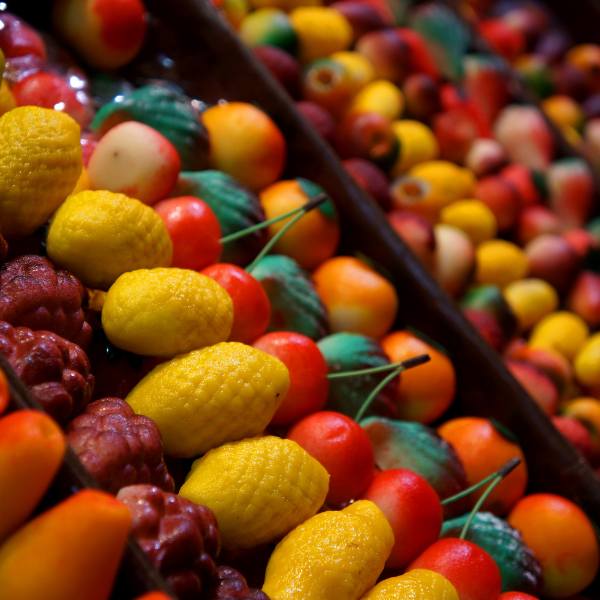 Trickery marzipan fruits!
Trickery marzipan fruits!The History of Lübecker Marzipan
The start of marzipan in Lübeck came to be in the 18th century. There is quite a debate over which country was the origin of marzipan. But Lübeck is the first recorded part of Germany to have it and make it.
There is an old theory that it came to be during a famine. While scarce on many things, sugar and almonds were of plenty. So why not mash it all together and make something new and sweet to eat?
Introducing: Almonds - The Ancient Advil
Another theory is that marzipan originated in Persia in the middle east during the middle ages, not so much as a delicacy but as a medicine. Records have been found of a physician from the year 860 who would write about creating healing remedies with almonds and sugar.
Wherever it came from, and whoever genuinely invented it first, it's interesting to think of how they would react now, seeing their invented remedy or snack grown into something that people fly from across the world to try.
Niederegger Arkadencafé
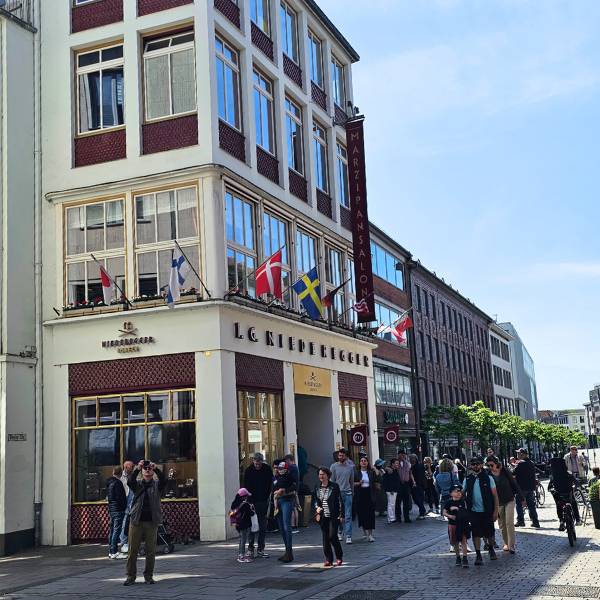 We were lucky enough to visit Niederegger's in person during our Germany tour, and taste test for ourselves!
We were lucky enough to visit Niederegger's in person during our Germany tour, and taste test for ourselves!Niederegger's is a historical stop every visitor should check out when visiting Lübeck. Niederegger was started in 1806 by a man who was later declared Lübeck's most masterful confectioner, Johann Georg Niederegger. His passing shook the city after erecting such a popular café. His quality standards and passion for the craft were unmatched.
But luckily for the people, the Niederegger family did everything they could to keep his legacy going and the proud tradition of marzipan manufacture alive.
From the ground up
In 1942, the café was engulfed in flames by enemy bombing but was rebuilt from the ground up starting in 1948. The new and improved café was given a new addition: an extra level up top. They weren't sure what to do with it at first, but realized they needed to build tourism again. So a museum was decided upon to show off Johann's old marzipan-making tools, molds, and even a recipe or two.
The bottom level is a store selling an array of marzipan products, from pure marzipan candy and those amazing cookies that Oma serves. This is the best place in Lübeck to buy authentic German marzipan and marzipan souvenirs to share with everyone back home.
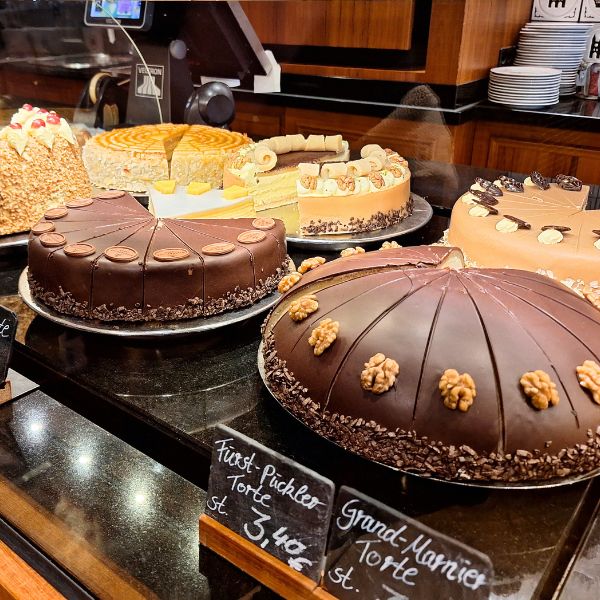 It was hard to decide on a slice, and there were even more upstairs!
It was hard to decide on a slice, and there were even more upstairs!Once you're done shopping around, visit the café part of the shop on the second floor. Here one can sit and enjoy a slice of the cafe's homemade marzipan cakes or however many as you want.
Grab a fresh hot cup of kaffee and have some social time over famous chocolate-covered marzipan cakes. Satisfy your sweet tooth with a delicious dessert before heading to the third floor to the museum.
Niederegger Museum
Upstairs, in the Niederegger Museum, one can learn more about the history of marzipan and just how on earth it made a city so famous.
Get a closer look at what the life of Johann and his fellow confectioners looked like working with marzipan every day. To some, it sounds like a dream job, and the technology and machines used to help make kitchen tasks easier now weren't around years ago. They had grinders to help break down the almonds, but what was used to crank that handle? Pure muscle. Machines weren't as independent as they are nowadays.
Be sure to check out the molds. It's so interesting to see what the popular shapes and styles were back then and which machines were used to assist in the making process.
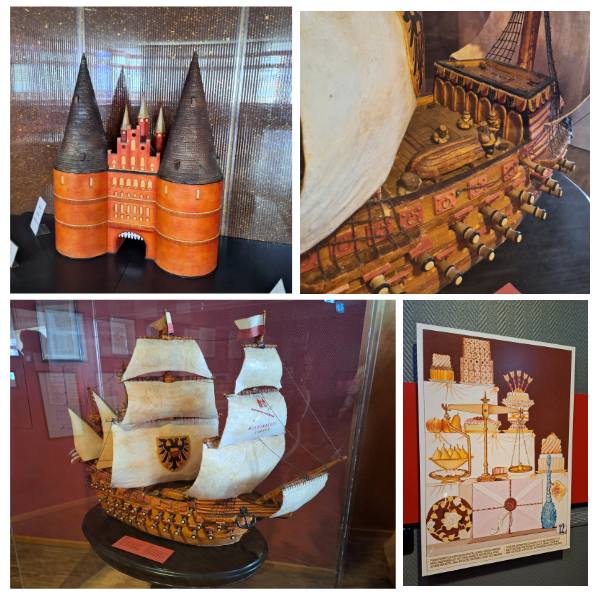 These miniature men must have taken SO long to sculpt! Someone had a lot of time on their hands.
These miniature men must have taken SO long to sculpt! Someone had a lot of time on their hands.See the famous sculptures made entirely out of marzipan paste. I was so fascinated by the marzipan mast ship. The details of the ship were so clean and intricate, and it took over 500 days to sculpt. Now that's commitment. No wonder it made it into a famous museum. Look at the tiny little marzipan crew!
The museum is informative, and the many statues depict just how important the sweet delicacy has been on the rise of Lübeck's tourism.
Joke Break!
How do you make pancakes on Mars? Using a marsipan!
It's hard to miss Niedereggers. It's often the busiest place in town! But another landmark is the famous town hall or Rathaus. The amazing historic and decorative architecture is a great photo op after you've toured Niederegger café and museum.
The 12th-century town hall is located directly across from the marzipan café in the market square. A popular spot for food trucks of plenty!
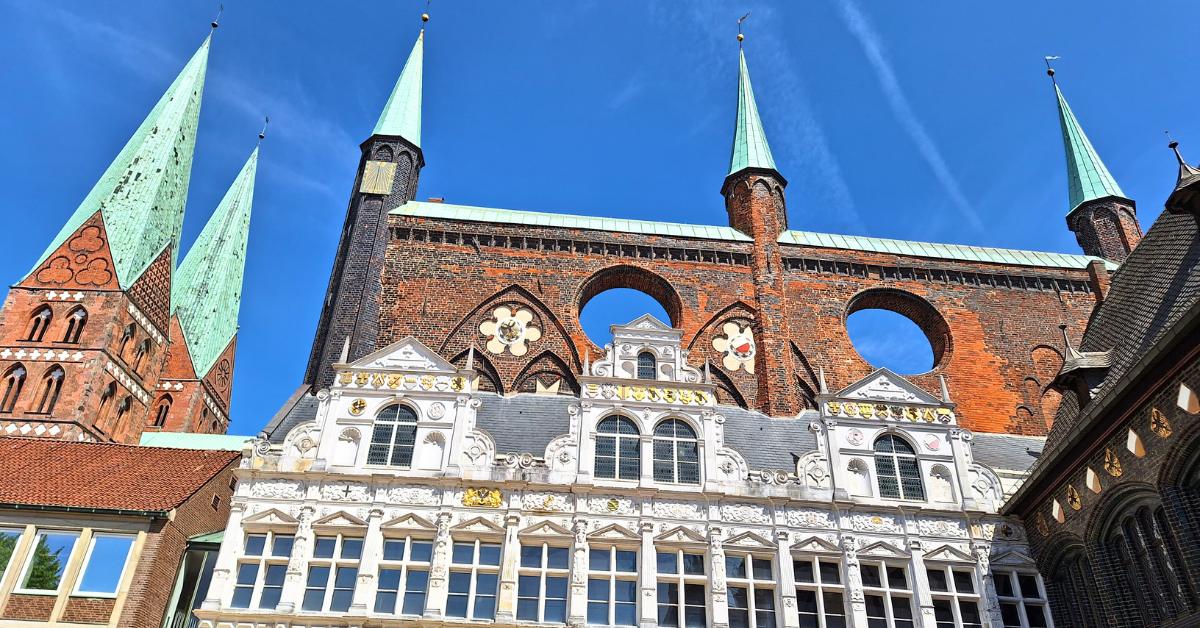 The famous and brilliantly decorated Rathaus
The famous and brilliantly decorated RathausMarzipanland
Marzipanland is a shop located right behind the famous Holsten Gate, Lübeck's 'melting' photo motif.
Marzipanland not only sells marzipan-themed gifts and treats to sit down and indulge in. But they also offer personalized sculpting classes. Get your hands dirty and throw that diet aside for a fun day of marzipan sculpting and snacking!
If you're anything like me when it comes to pottery and sculpting clay… then it's a good thing there are top-notch sculpture chefs here to help. Each class offers a demonstration on how to work with and mold the marzipan, the shop's history and access to carving tools, and of course, marzipan taste tests.
From here, get creative! Sculpt whatever your heart desires. (Just no giant marzipan sailships like Niedereggers ...) I don't think the teachers want to be there for over 500 days.
Certified Mastery!
Oops, I forgot to mention the best part. When carving and tasting are all said and done, you won't only leave with an array of snacks and newfound knowledge of sculpting paste like a master. You'll be leaving with a diploma to declare your graduation from the School of Marzipan! I do say that is an in-a-frame hang-on-a-wall worthy piece of paper. Paste sculptor? What a mastery to declare.
After a busy day on the marzipan hunt and tasting train, perhaps a sightseeing stroll will take the mind off of your full tummy.
The Leaning Tower of ... Lübeck?
Holsten Gate
The city's symbol was also a 14th-century defense mechanism. The two towers lean across the middle part of the gate. Or so it seems. "Dun, Dun, Dunnn!"
The perplexing part of this architecture is that it appears as if it's leaning from one side. Look back as you walk under the gate and pass through to the city side. Notice anything different? It's not leaning. From the city side, the gate appears perfectly normal. But from the entrance, on the field side, the gate leans. Well, this wasn't a mess up in architectural blueprints or design. But a mistake on the grounds behalf.
The area that the front of the gate is on has lots of clay like soil instead of steady ground, making it a mushy and unsteady. This is causing the gates entrance to lean and appear like it's melting! Don't worry, it won't come tumbling down for a few more hundred years.
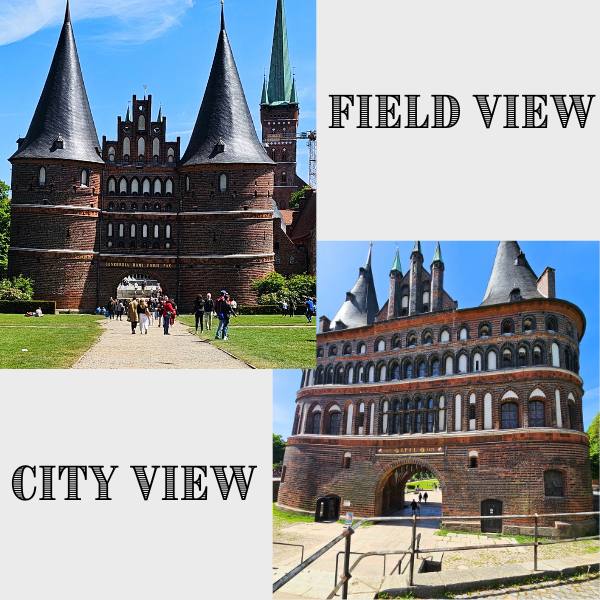 The strangest sight! You'd think it was a completely different building from the other side.
The strangest sight! You'd think it was a completely different building from the other side.Let Em' Fly Boys!
The windows of the field side along the top and on the southern and northern towers were used as launching points for archers to defend against any brave attempts to enter through the city gate. At the same time, the rest of the windows on the city side were used to throw hot water and launch arrows down on intruders. Yikes, you'd hate to be that guy.
Locked In
Lock Covered Bridge
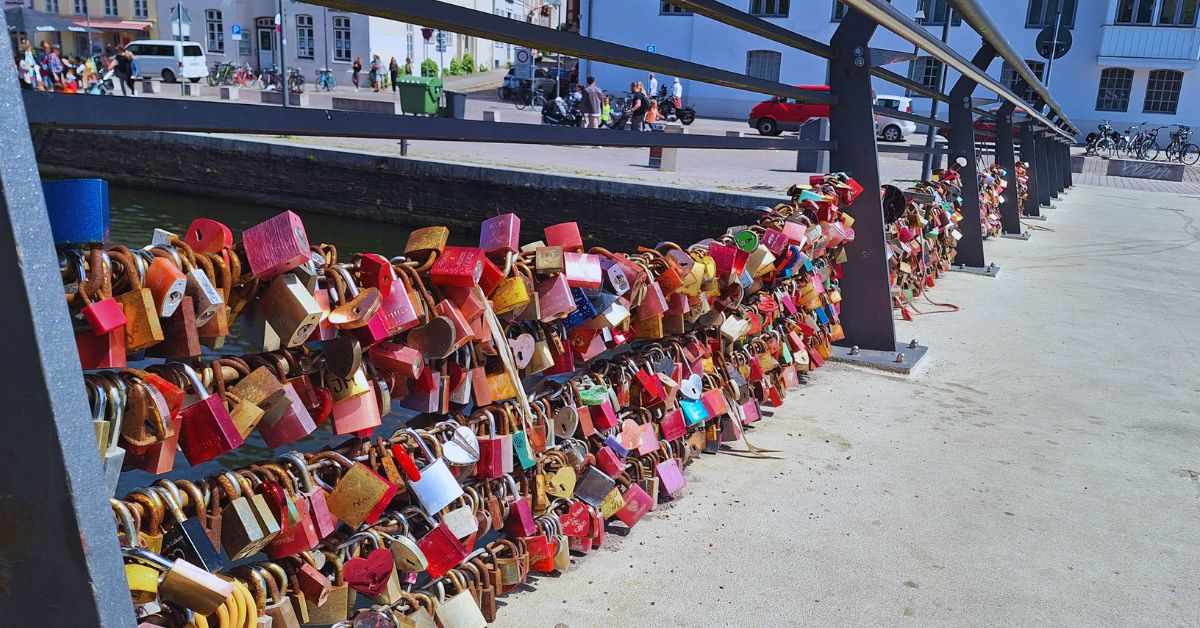 One can't help but wonder how much extra weight these add to the bridge? Weight limits incoming?
One can't help but wonder how much extra weight these add to the bridge? Weight limits incoming?Here's a lovely spot to stop and take in the amazing view of Lübeck's Canal. It's one of Lübeck's many walkways over the peaceful kayak-filled water.
But this one is something special. Much like the famous lock bridge in Cologne, this one is covered end to end, rail to rail, in lovers' locks.
People travel here just to get their love locked on a rail for eternity. I wonder if this became a tradition after the Cologne bridge filled up and people ran out of spots. So up next to fill was the romantic scene of Lübeck.
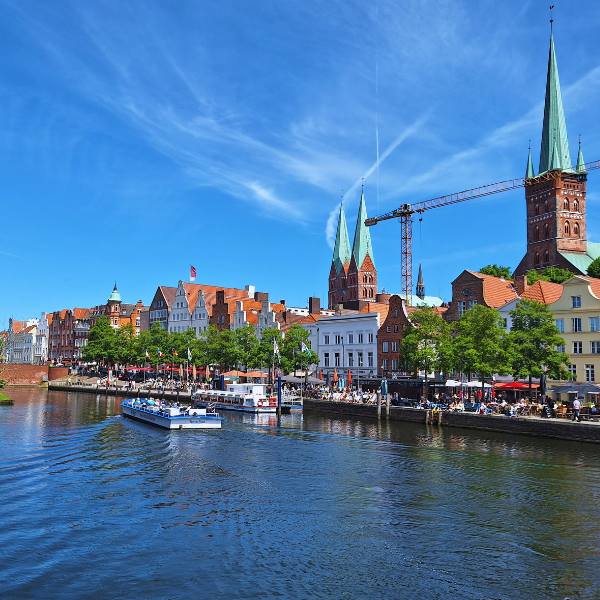 Photobombed by construction equipment... the story of a tourist in Germany.
Photobombed by construction equipment... the story of a tourist in Germany.Now that's a photo album-worthy view right there, if people still partake in those. Minus the crane, but hey, it's hard to avoid construction in Europe.
Now you can say that you've visited the city of Lübeck! Parts of it, at least, through a screen. The journey there is up to you. What will be on your list to see? Will you be stopping by Niederegger's for sweet treats?



























